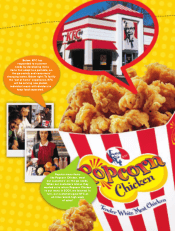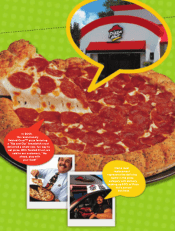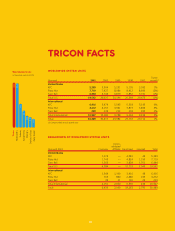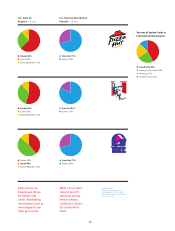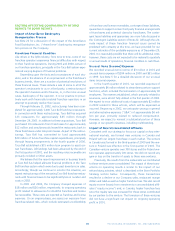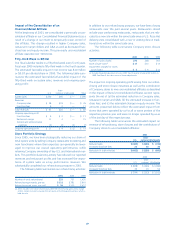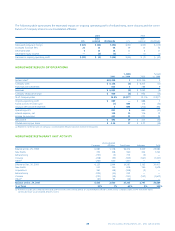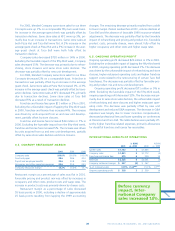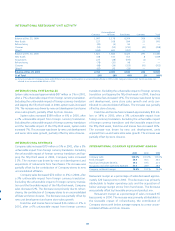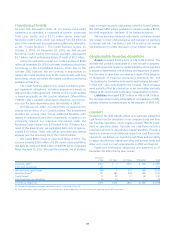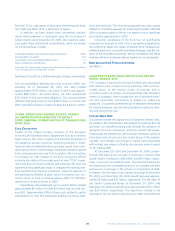Pizza Hut 2001 Annual Report Download - page 28
Download and view the complete annual report
Please find page 28 of the 2001 Pizza Hut annual report below. You can navigate through the pages in the report by either clicking on the pages listed below, or by using the keyword search tool below to find specific information within the annual report.26 TRICON GLOBAL RESTAURANTS, INC. AND SUBSIDIARIES
FACTORS AFFECTING COMPARABILITY OF 2001
RESULTS TO 2000 RESULTS
Impact of AmeriServe Bankruptcy
Reorganization Process
See Note 22 for a discussion of the impact of the AmeriServe
Food Distribution, Inc. (“AmeriServe”) bankruptcy reorganiza-
tion process on the Company.
Franchisee Financial Condition
Like others in the QSR industry, from time to time, some of our
franchise operators experience financial difficulties with respect
to their franchise operations. During 2001 and 2000, certain of
our franchise operators, principally in the Taco Bell system expe-
rienced varying degrees of financial problems.
Depending upon the facts and circumstances of each situ-
ation, and in the absence of an improvement in the franchisee’s
business trends, there are a number of potential resolutions of
these financial issues. These include a sale of some or all of the
operator’s restaurants to us or a third party, a restructuring of
the operator’s business and/or finances, or, in the more unusual
cases, bankruptcy of the operator. It is our practice to proac-
tively work with financially troubled franchise operators in an
attempt to positively resolve their issues.
Through February 11, 2002, restructurings have been com-
pleted for approximately 1,000 Taco Bell franchise restaurants.
In connection with these restructurings, Taco Bell has acquired
123 restaurants for approximately $65 million through
December 29, 2001. In addition to these acquisitions, Taco Bell
purchased 19 restaurants from franchisees for approximately
$12 million and simultaneously leased the restaurants back to
these franchisees under long-term leases. As part of the restruc-
turings, Taco Bell has committed to fund approximately
$29 million of future franchise capital expenditures, principally
through leasing arrangements. In the fourth quarter of 2000,
Taco Bell established a $15 million loan program to assist cer-
tain franchisees. All fundings had been advanced by the end of
the first quarter of 2001, and the resulting notes receivable are
primarily included in Other assets.
We believe that the recent improvement in business trends
at Taco Bell has helped alleviate financial problems in the Taco
Bell franchise system which were due to past downturns in sales.
Accordingly, though we continue to monitor this situation, we
expect restructurings of the remaining Taco Bell franchise restau-
rants with financial issues to be significantly less in number and
costs in 2002.
In 2001 and 2000, the Company charged expenses of
$18 million and $26 million, respectively, to ongoing operating
profit related to allowances for doubtful franchise and license
fee receivables. These costs are reported as franchise and license
expenses. On an ongoing basis, we assess our exposure from
franchise-related risks, which include estimated uncollectibility
of franchise and license receivables, contingent lease liabilities,
guarantees to support certain third party financial arrangements
of franchisees and potential claims by franchisees. The contin-
gent lease liabilities and guarantees are more fully discussed in
the Contingent Liabilities section of Note 22. Although the ulti-
mate impact of these franchise financial issues cannot be
predicted with certainty at this time, we have provided for our
current estimate of the probable exposure as of December 29,
2001. It is reasonably possible that there will be additional costs;
however, these costs are not expected to be material to quarterly
or annual results of operations, financial condition or cash flows.
Unusual Items (Income) Expense
We recorded unusual items income of $3 million in 2001 and
unusual items expense of $204 million in 2000 and $51 million
in 1999. See Note 5 for a detailed discussion of our unusual
items (income) expense.
In the fourth quarter of 2001, we recorded expenses of
approximately $4 million related to streamlining certain support
functions, which included the termination of approximately 90
employees. The reserves established, which primarily related to
severance, were almost fully utilized in the first quarter of 2002.
We expect to incur additional costs of approximately $2 million
in 2002 related to these actions, which will be expensed as
incurred. Beginning in 2002, we anticipate savings in general
and administrative expenses (“G&A”) of approximately $6 mil-
lion per year, primarily related to reduced compensation.
However, we expect to reinvest a substantial portion of these
savings in our growth initiatives, including multibranding.
Impact of New Unconsolidated Affiliates
Consistent with our strategy to focus our capital on key inter-
national markets, we formed new ventures in Canada and
Poland with our largest franchisee in each market. The venture
in Canada was formed in the third quarter of 2000 and the ven-
ture in Poland was effective in the first quarter of 2001. The
Canadian venture operates over 700 stores and the Poland ven-
ture operates approximately 100 stores. We did not record any
gain or loss on the transfer of assets to these new ventures.
Previously, the results from the restaurants we contributed
to these ventures were consolidated. The impact of these trans-
actions on operating results is similar to the impact of our
refranchising activities, which is described in the Store Portfolio
Strategy section below. Consequently, these transactions
resulted in a decline in our Company sales, restaurant margin
dollars and G&A as well as higher franchise fees. We also record
equity income (losses) from investments in unconsolidated affil-
iates (“equity income”) and, in Canada, higher franchise fees
since the royalty rate was increased for those stores contributed
by our partner to the venture. The formation of these ventures
did not have a significant net impact on ongoing operating
profit in 2001.


